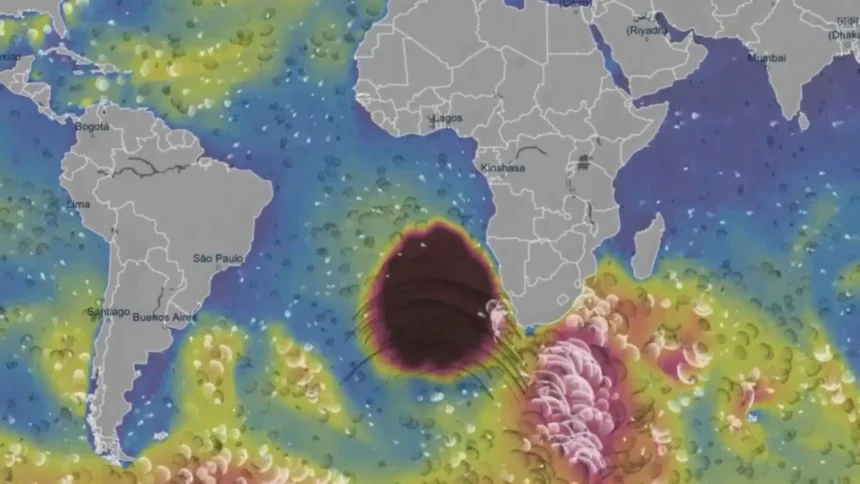The African Ocean Anomaly was a big wave event off Africa’s coast on April 10, 2024. It was a huge wave cluster over 80 feet tall and about 2,000 miles wide, almost as big as Texas.
People first thought it might be from aliens or underwater vehicles, but it turned out to be a mistake in the weather prediction system.
The Science Behind Ocean Anomalies
Ocean waves are created when wind energy moves across the water, mainly due to wind speed, distance it travels, and how long it blows.
Wind friction makes small ripples that turn into bigger waves as energy builds up. Wave size and shape depend on wind’s strength and duration, as well as how far it moves.
To study the ocean, scientists use satellites, buoys, and weather models to gather data on wind, waves, and currents.
This helps in predicting ocean conditions and understanding how waves might affect coastlines.
Tools like NOAA’s National Data Buoy Center and modeling software are crucial for this research.
Initial Reactions and Speculations
In April 2024, a huge wave phenomenon called the African Ocean Anomaly caught the world’s attention.
This wave, which was over 80 feet tall and as big as Texas, quickly became viral on social media platforms like TikTok and Reddit, with many people discussing it.
Some people thought aliens or mysterious underwater objects might be responsible, while others compared it to legends and myth, mixing science with fiction.
The Role of Social Media in Shaping Theories
Social media, especially Twitter and YouTube, greatly helped spread rumors about the African Ocean Anomaly.
A tweet about the anomaly was shared many times, including by a “think tank” account that got over 163,000 views in just seven hours.
This account mentioned the anomaly was as big as Texas and might be a UFO. Another YouTube video showed the anomaly’s size using satellite maps, estimating it to be about 2,000 miles long and 1,510 miles wide.
The video’s comments were filled with jokes and theories about its origin, like asteroids, aliens, sea monsters, or just a mistake in data.
Memes and funny posts also appeared, like jokes about lost Uber drivers and the Cthulhu creature from H.P. Lovecraft’s stories.
This widespread sharing of content led to a lot of interest and speculation about the anomaly.
The Extraterrestrial Hypothesis
The African Ocean Anomaly has sparked talks about possible alien activity, with some people thinking the big wave might be from unknown underwater vehicles or even alien spaceships.
This idea is based on past UFO sightings, where strange flying things were thought to be connected to underwater things, suggesting aliens might live in the oceans instead of space.
This theory is driven by a long-standing interest in the unknown, like mythical sea creatures and strange underwater events.
Experts believe the African Ocean Anomaly is due to a mistake in weather prediction models, highlighting the importance of careful thinking when considering these wild claims.
The Cthulhu Connection
Speaking of ‘African ocean anomaly’, the story “The Call of Cthulhu” by H.P. Lovecraft tells the tale of a giant, scary creature called Cthulhu, who sleeps deep in the ocean under a city called R’lyeh.
Cthulhu looks like a monster with tentacles and dragon-like features, showing how people are scared of the sea’s mysteries and the unknown.
This story has become a big part of how we think about strange things happening in the ocean, like mysterious sounds or lights.
It’s a mix of horror and the unknown, making people wonder if ancient, powerful beings are hiding in the sea.
Lovecraft’s stories about Cthulhu and other sea monsters have made people more curious and scared about what’s happening in the ocean, linking these stories to real-life ocean mysteries.
Scientific Explanations for the African Ocean Anomaly
The first sign of the African Ocean Anomaly was caused by a mistake in the weather prediction system used by Ventusky, which combines current ocean and weather information.
A Ventusky spokesperson said that the anomaly, which looked like a huge wave, was because of this mistake, which has now been fixed.
Experts, like Professor Roy Grainger from Oxford University, said that the wave pattern was due to vortex shedding, a natural event that happens when water moves around something, creating up-and-down forces.
This shows that the African Ocean Anomaly was probably caused by natural reasons, not by aliens, which became popular but not true stories.
The Impact of the Anomaly on Oceanography
The African Ocean Anomaly has brought attention back to studying and exploring the ocean, showing the need for better ways to monitor and understand complex weather and ocean conditions.
This event highlights the difficulties in quickly analyzing data and the risk of making mistakes.
Moving ahead, scientists will probably work on creating stronger models and checking data from different sources to make sure ocean observations are accurate.
The African Ocean anomaly has also made people more interested in unusual wave patterns and how they relate to weather.
Public Fascination with the Unknown
People are naturally curious about the ocean because it’s mysterious, scary, and exciting. The ocean is still unexplored and has many unknown things that make us wonder.
This curiosity is also linked to the idea of aliens, which makes us want to connect with something bigger and more amazing.
Research shows that people who think aliens exist often have creative minds and believe in things that aren’t proven.
This mix of stories, our minds, and our desire to learn more about the ocean and aliens keeps us interested in these topics.
The African Ocean Anomaly shows the secrets hidden in the ocean and the need for careful thinking when dealing with strange events.
At first, people were excited but later found a mistake in the calculations, showing how important it is to be thorough in science.


Leave a Reply